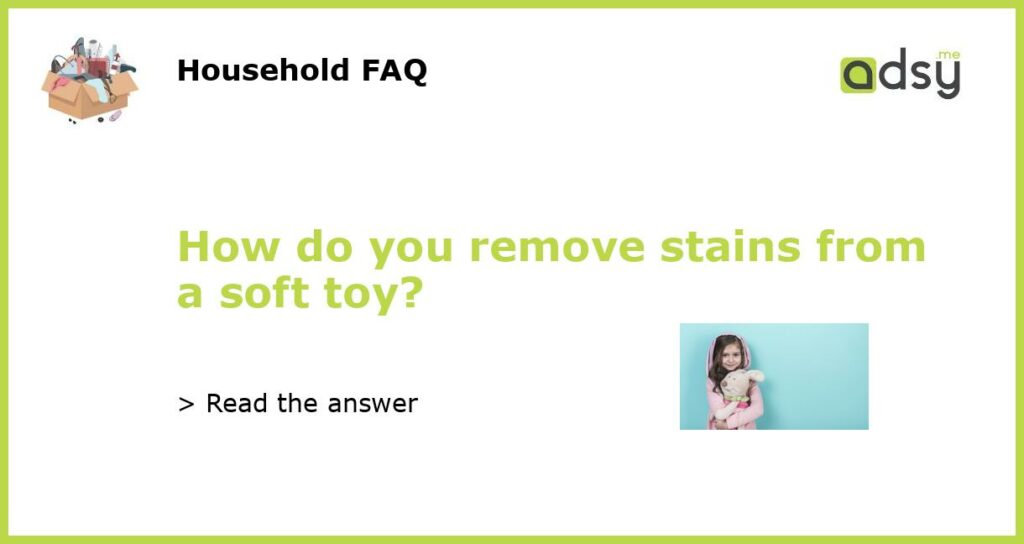Identify the type of stain
Before attempting to remove stains from a soft toy, it’s important to identify the type of stain you’re dealing with. This will help determine the best approach to take for effective stain removal. Common types of stains on soft toys include food stains, ink stains, dirt stains, and bodily fluid stains.
Check the care label
Before proceeding with stain removal, it’s crucial to check the care label on the soft toy. The care label provides important information on how to clean the toy, including any specific instructions or warnings. Some soft toys may not be washable, or may require special care, such as hand washing only or avoiding certain cleaning products.
Pre-treat the stain
Once you’ve identified the type of stain and checked the care label, it’s time to pre-treat the stain. This step is essential for breaking down and loosening the stain before washing. The method for pre-treating the stain will depend on the type of stain you’re dealing with:
- Food stains: Scrape off any excess food and then blot the stain with a mixture of mild dish soap and warm water. Let it sit for a few minutes before gently scrubbing the stain with a soft-bristled brush. Rinse with water.
- Ink stains: Blot the stain with a cloth dampened with rubbing alcohol. Avoid rubbing the stain, as it may cause it to spread. Rinse with water.
- Dirt stains: Brush off any loose dirt and then blot the stain with a mixture of mild dish soap and warm water. Let it sit for a few minutes before gently scrubbing the stain with a soft-bristled brush. Rinse with water.
- Bodily fluid stains: Blot the stain with a cloth dampened with a mixture of mild dish soap and warm water. Let it sit for a few minutes before gently scrubbing the stain with a soft-bristled brush. Rinse with water.
Wash the soft toy
After pre-treating the stain, it’s time to wash the soft toy. The care label will determine the appropriate washing method:
- Machine-washable: If the care label indicates that the toy is machine-washable, place it in a mesh laundry bag to protect it and prevent any small parts from coming loose. Use a gentle cycle and cold water, along with a mild detergent. Avoid using bleach or fabric softener. After washing, remove the toy from the laundry bag and let it air dry.
- Hand-washable: If the care label indicates that the toy is hand-washable, fill a basin with lukewarm water and a mild detergent. Gently agitate the toy in the soapy water, paying particular attention to any stained areas. Rinse with clean water until all soap suds are gone. After washing, gently squeeze out any excess water and let the toy air dry.
- Spot-cleaning only: If the care label indicates that the toy can only be spot-cleaned, dampen a clean cloth with water and a mild detergent. Gently blot the stained areas, being careful not to oversaturate the toy. After spot-cleaning, use a clean, damp cloth to remove any residual detergent. Allow the toy to air dry.
Dry and fluff the toy
Once the soft toy is clean, it’s important to properly dry and fluff it to maintain its shape and texture:
- Air drying: Place the washed toy on a clean towel and gently press out any excess water. Avoid wringing or twisting the toy, as this can cause damage. Allow the toy to air dry in a well-ventilated area away from direct sunlight or heat sources. To restore the toy’s fluffiness, gently shake and fluff it once it is completely dry.
- Machine drying: If the care label allows for machine drying, place the toy in a mesh laundry bag and set the dryer to a low heat or delicate cycle. Add a few clean, dry towels to the dryer to help absorb moisture and reduce the risk of the toy getting damaged. Check on the toy periodically to ensure it doesn’t shrink or lose its shape. Once dry, remove the toy from the laundry bag and fluff it gently.






